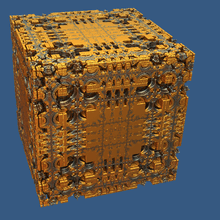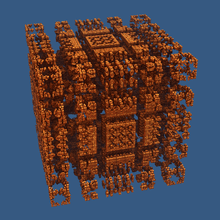Mandelbox


In mathematics, the mandelbox is a fractal with a boxlike shape found by Tom Lowe in 2010. It is defined in a similar way to the famous Mandelbrot set as the values of a parameter such that the origin does not escape to infinity under iteration of certain geometrical transformations. The mandelbox is defined as a map of continuous Julia sets, but, unlike the Mandelbrot set, can be defined in any number of dimensions.[1] As a result, it is an example of a multifractal system. It is typically drawn in three dimensions for illustrative purposes.
Generation
The iteration applies to vector z as follows:
function iterate(z):
for each component in z:
if component > 1:
component := 2 - component
else if component < -1:
component := -2 - component
if magnitude of z < 0.5:
z := z * 4
else if magnitude of z < 1:
z := z / (magnitude of z)^2
z := scale * z + c
Here, c is the constant being tested, and scale is a real number.
A notable property of the mandelbox, particularly for scale -1.5, is that it contains approximations of many well known fractals within it.[2][3][4]
See also
Notes
- ↑ Lowe, Tom. "What Is A Mandelbox?". Archived from the original on 2016-10-08. Retrieved 15 November 2016.
- ↑ negative-mandelbox
- ↑ more-negatives
- ↑ mandelbox_3d_fractal
References
- Leys, Jos (2010), Mandelbox. Images des Mathématiques, CNRS